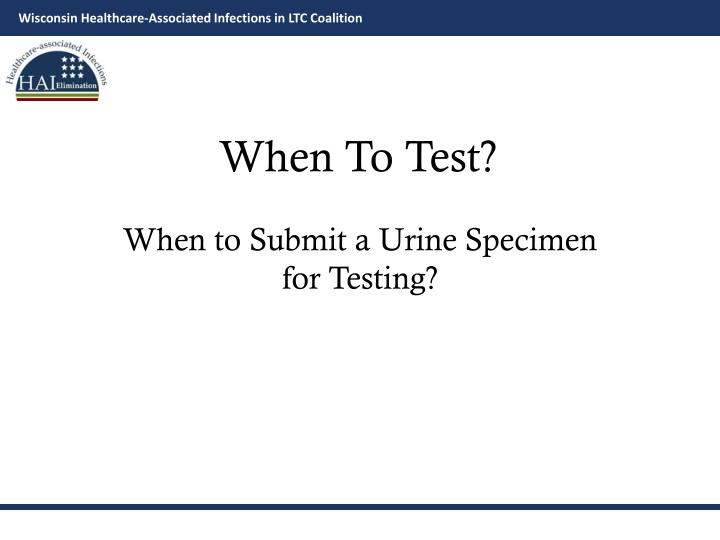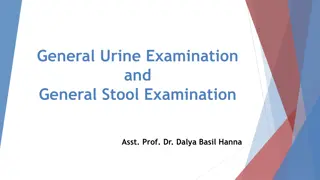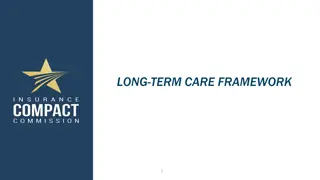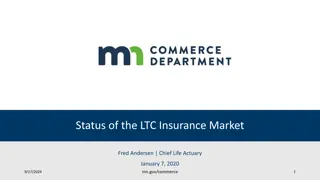**Wisconsin Healthcare-Associated Infections in LTC Coalition: Urine Testing Guidelines**
The Wisconsin Healthcare-Associated Infections in LTC Coalition provides guidelines on when to test and submit urine specimens for testing in long-term care facilities. The focus is on reducing unnecessary urine testing, introducing tools like the UTI Stoplight Tool and the When To Test-Nursing Tool, and managing residents with low probability of UTI. The coalition emphasizes the potential harm of unnecessary urine tests, such as missed diagnoses and antibiotic overuse leading to adverse effects. Antibiotic-associated adverse drug events are highlighted as a common issue in nursing homes.
Download Presentation

Please find below an Image/Link to download the presentation.
The content on the website is provided AS IS for your information and personal use only. It may not be sold, licensed, or shared on other websites without obtaining consent from the author.If you encounter any issues during the download, it is possible that the publisher has removed the file from their server.
You are allowed to download the files provided on this website for personal or commercial use, subject to the condition that they are used lawfully. All files are the property of their respective owners.
The content on the website is provided AS IS for your information and personal use only. It may not be sold, licensed, or shared on other websites without obtaining consent from the author.
E N D
Presentation Transcript
Wisconsin Healthcare-Associated Infections in LTC Coalition When To Test? When to Submit a Urine Specimen for Testing?
Wisconsin Healthcare-Associated Infections in LTC Coalition UTI Toolkit Module 3 Narration by: Anna Eslinger, RN Infection Preventionist Marshfield Medical Center - Eau Claire Content developed in partnership with the Wisconsin Healthcare-Associated Infections in Long-Term Care Coalition Funding for this project was provided by the Wisconsin Partnership Program at the UW School of Medicine and Public Health
Wisconsin Healthcare-Associated Infections in LTC Coalition Objectives Reinforce the benefits of reducing unnecessary urine testing Introduce the UTI Stoplight Tool Introduce the When To Test-Nursing Tool Briefly describe how to manage residents who have isolated, non-specific geriatric symptoms (low probability of UTI) Nace, et.al. JAMDA 2014; 15(2): 133-39
Wisconsin Healthcare-Associated Infections in LTC Coalition Urine Cultures Are a Common Trigger for Antibiotic Use in Nursing Homes It is hard for providers to ignore a positive urine culture, even when the resident does not exhibit specific UTI symptoms. Figure 1: Timing of Urine Culture Results and Antibiotic Starts 1 0.8 Nearly 80% of antibiotic courses initiated for treatment of UTI are started after urine cultures are resulted (Figure 1). 0.6 0.4 0.2 0 A majority of these residents had asymptomatic bacteriuria and did not exhibit any localizing signs or symptoms of UTI. Facility 1 Facility 2 Facility 3 Facility 4 Started after UCx Resulted Started before UCx Resulted Phillips et al. BMC Geriatr 2012; 12: 73
Wisconsin Healthcare-Associated Infections in LTC Coalition Potential Harm Created by Sending Unnecessary Urine Tests Miss Other Important Diagnoses Medication Side Effect Dehydration Uncontrolled Pain Constipation Sleep Deprivation Hypoglycemia Electrolyte Abnormality Low O2 / High CO2 Stroke/Seizure Overuse Antibiotics Which Can Cause a Variety of Resident Harms* 1 2 20% of all adverse drug events (ADEs) in nursing homes caused by antibiotics Antibiotic-associated ADEs are one of the most common reasons for transfer to ER ADE C. difficile infection (CDI) is a life-threatening intestinal disease caused by antibiotics 12% of nursing home residents treated inappropriately for UTI develop CDI CDI ~50% of nursing residents are colonized with Abx-resistant organisms (AROs) Antibiotic exposure is the single most important risk factor for ARO colonization ARO * See Clinical Rationale in Module 1 for more detail.
Wisconsin Healthcare-Associated Infections in LTC Coalition Benefits of Reducing Unnecessary Urine Culture Testing 12 Massachusetts nursing homes participated in a QI project to reduce urine testing in residents who presented with non-specific geriatrics symptoms (e.g., behavior change) and did not have other specific symptoms. Figure: Impact of Reducing Urine Culture Testing Urine culture and UTI treatment rates dropped significantly (Figure & Table). Measure IRR (95% CI) Rates of Clostridium difficile improved but not to statistically significant degree (Table). Urine Culture Rate 0.47 (0.42 0.52) UTI Rate 0.42 (0.35 0.50) C. difficile Rate 0.85 (0.45 1.68) Massachusetts Coalition for Patient Safety
Wisconsin Healthcare-Associated Infections in LTC Coalition UTI Stoplight Tool Intended to help nursing staff determine if a resident experiencing a change-in-condition has a high probability of UTI (green light) or a lower probability of UTI (red and yellow light). The tool has been incorporated into educational pamphlets as well as posters in order to make it readily available to staff and providers. Nursing staff should be encouraged to specify their determination of the resident s UTI probability during their initial communication with providers about a new resident change-in-condition.
Wisconsin Healthcare-Associated Infections in LTC Coalition When To Test-Nursing Tool The tool can be used to train nursing staff on how to assess their residents, what parts of the assessment to pay attention to and when they need to contact the provider* The tool is intended to be used in conjunction with communication scripts that have been developed for different types of resident change in condition* The tool may also be incorporated into handouts and poster reminders for nursing work spaces *See Nursing Tool: Application to Case Studies and Development of Provider Communication Scripts in Module 3.
Wisconsin Healthcare-Associated Infections in LTC Coalition When To Test Nursing Tool Adapted from Crnich & Drinka. Ann Long Term Care 2014; July: 43-7
Wisconsin Healthcare-Associated Infections in LTC Coalition When To Test Nursing Tool Adapted from Crnich & Drinka. Ann Long Term Care 2014; July: 43-7
Wisconsin Healthcare-Associated Infections in LTC Coalition When To Test Nursing Tool Adapted from Crnich & Drinka. Ann Long Term Care 2014; July: 43-7
Wisconsin Healthcare-Associated Infections in LTC Coalition What is Active Monitoring? 1. Re-examining and measuring vital signs more frequently Example: Temporary Care Plan Order set 2. Reviewing medications, bowel/bladder patterns, sleep patterns and social milieu to identify potential triggers 3. Promoting fluid intake (IV/PO) if there is concern for dehydration 4. Contacting provider at as needed and with development of localizing signs/symptoms or warning signs 5. Obtaining additional labs (not urine tests though!)
Wisconsin Healthcare-Associated Infections in LTC Coalition Why Active Monitoring? Rapidly detect any further deterioration that would require repeat conversation with provider and more aggressive intervention Provide additional information that might help identify the cause of change in condition (e.g., constipation, inadequately managed pain, etc.) Initiation of fluids may help correct dehydration which may be triggering the change in the first place Provides a talking point for conversations with family that reassures them that staff are keeping a very close eye on their loved one
Wisconsin Healthcare-Associated Infections in LTC Coalition When To Test Nursing Tool Adapted from Crnich & Drinka. Ann Long Term Care 2014; July: 43-7
Wisconsin Healthcare-Associated Infections in LTC Coalition Summary When to Test The WI UTI Toolkit can be employed to create a shared understanding of when to perform testing on urine samples Test the urine only when there are specific urinary tract signs or symptoms Develop/adopt an active monitoring temporary care plan to help nursing staff structure the management of residents who have a less concerning change in condition























